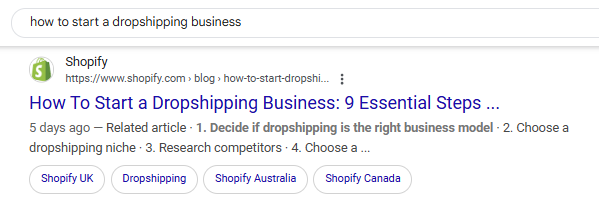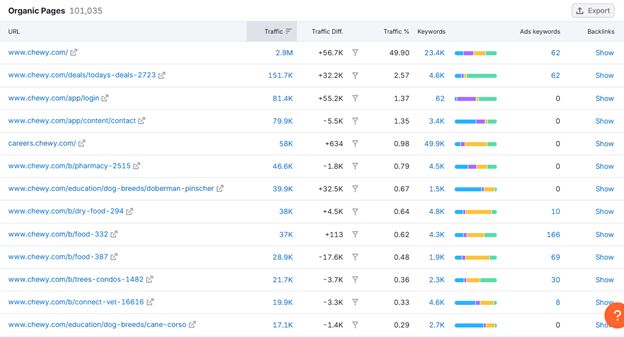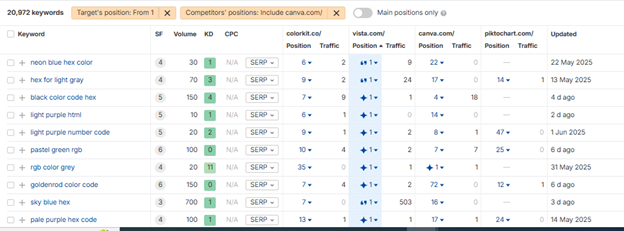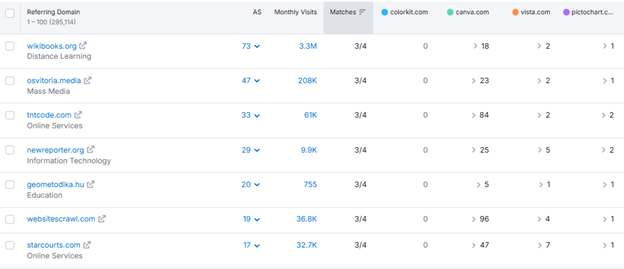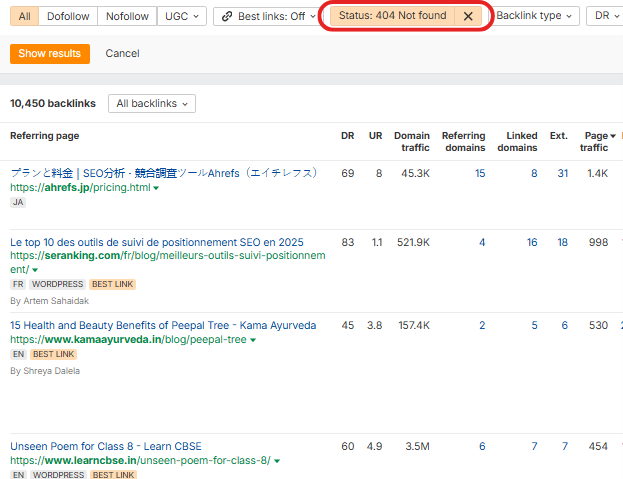Your website is up and running, but there are no users, prospects, customers, or visitors driving to your webpages? Where are they going exactly?
To your competitor sites.
Is it possible to capture this traffic for your website? Possibly.
For that, you need to plan and conduct thorough SEO competitor research, and perform an audit of your website. This allows you to get complete insights into your current search standing and analyze strategic gaps that need to be addressed.
An Ahrefs study indicated that 96.55% of pages on Google get zero traffic. This means that you only have a 3.45% margin for opportunity hunting. To land in this tiny margin, you must analyze, evaluate, and understand your competitor’s SEO strategy.
SEO competitor analysis involves studying the SERPs for the most successful domains in your niche. Your competitors can either be your worst enemy or a treasure of hidden possibilities — it depends on how you look at it. In this article, we’ll concoct the perfect recipe for you to make the most out of your competitor data. This includes:
- Discovering who your real SEO competitors are.
- Exploring the keywords they target and the content they create.
- Breaking down their backlink strategies.
- Assessing their technical SEO performance.
- Transforming your findings into actionable strategies.
Why Is It Important To Run SEO Competitor Analysis?
Your SEO strategy is just one part of the equation — your competitor insights work like the missing pieces of a puzzle to help you reach your SEO objectives. This is why, when putting together a plan of action for search engine rankings, running an SEO competitor analysis is one of the first few steps.
The process lets you generate a success blueprint for your website by leveraging insights from organic competitors in your niche. Using the collected data from your competitor analysis is great for the following reasons:
- Get a peek into the existing competition within your niche.
- Draw upon their shortcomings to craft a winning SEO plan.
- Identify gaps in their content and use them to your advantage.
- Reverse engineer their success strategies to boost your website traffic.
- Prioritize tasks based on what they are focusing on.
- Know what is and isn’t working for others in your industry to avoid potential blunders.
This information is highly valuable for someone who is looking to outrank their competitors. The process involves replication and adaptation of the strategies used by successful players in your industry, so you can grow and eventually build your capital on those tactics.
Why You Need To Run Competitor Audits & How It Helps?
Every SME to large corporation needs regular competitor audits; either to build their strategy on a solid foundation or to benchmark their performance against their adversaries. But how do you know you need to perform an SEO competitor analysis? It’s like this meme here. You won’t know instantly, but there will be signs.
What are these signs? Probably declining traffic, lack of conversions, and a scarcity in the number of KPIs met. These are often the first warning signs when a fire is about to happen in your digital business. What’s the fastest and most effective way to overcome this in the SEO dictionary? Reverse-engineer the strategies of your strongest competitors.
It won’t be wrong to say that competitor website analysis is among the core practices that help you claim the center stage in search engine rankings. Gaining an edge in the SERP race involves leveraging the insights gained through thorough competitor analysis to boost your website traffic.
Keyword Hunting — Analyze how they match search intent and replicate similar search terms in your content.
Content Planning — Study how your top competitors have created content for a specific keyword. Make that the foundation on which you create your own content — using a unique take and filling content gaps to get an edge.
Diagnosing Performance Lags — Oftentimes, your website is dropping in the SERP not because you’re doing something wrong, but because your competitors are doing it better. Performing an SEO competitor analysis helps identify areas you must address to reclaim lost rankings.
How to Perform a Full SEO Competitor Audit?
Let’s dive deeper into how to do competitor analysis for SEO. In general, it should cover the following areas. Four areas to cover
- Competitor Keywords
- Competitor Content
- Backlinks
- Technical SEO Analysis
Following this standard will give you a complete overview of your online competition, helping better strategize and plan future campaigns for better returns.
But where to start with researching your competitors for a particular niche? Review this complete SEO competitor analysis checklist to lay the foundation of your success.
Identify Who Your Competitors Are
Finding your SEO competitors means sneaking through the web to find websites ranking for your niche keywords. But first, you must ask yourself questions like:
- What are your target keywords?
- What are your digital sales goals?
- Where do you stand as a brand?
This will help analyze your online competition based on your current KPIs. However, it’s important to note that your online competition does not necessarily reflect your conventional business competitors. For example, Shopify ranks for ‘how to start a dropshipping business’, but it’s not a direct competitor of dropshipping suppliers or marketplaces.
This means that it can be tricky to identify exactly which players you’re up against in an online battle. But precision is key. Keeping an eye on all the keywords in your niche, and the ranking websites for those keywords is the best way to achieve accuracy.
Analyze Domain Authority Of Your Competition
Domain Authority, a.k.a. DA, is a Moz grading system that predicts how likely a website is to rank on the SERP. This value depends on multiple factors, such as:
- Content Authority
- E-E-A-T Signals
- Backlinks & Social Signals
- Website User Experience
- Site Age
- Technical SEO Factors (selected)
How do you find domain authority? Just head over to our Domain Metrics tool and drop in your competitors’ website domains. It will give you DA, DR, PA, Spam Score, & Traffic insights.
Reading into the domain authority of your competitors is important, as it provides insights into the level of effort you’ll require to outgrow your competition. It tells you how strong your opponents are, so you are better equipped to confront them on search engines.
Although some of your competition might fall beyond your ranking potential. For example, the biggest players like Canva and Adobe are not in the scope of competition for a small design website like Kittl. So, sticking to rivals that can be surpassed is the best strategy to employ.
Fish Out Competitors Using An SEO Tool
A great way to begin competitor research is by using third-party tools that provide auto-suggestions for competitors. Our favourite for SEO competitor analysis is Semrush, as it pulls up your closest competitors and represents trends using keyword and traffic mapping.
Head to the Organic Research tab, and navigate to Competitors. This is what you’ll see — a complete list of organic competitors and a Competitive Positioning Map to help you visualize your current competition.
Remember, these are your SEO competitors and may not necessarily have the same business model as you do. However, they are probably driving traffic away from your target pages, which is why they must be identified and studied, so you can overtake your niche-specific spots on the SERP.
Find Keyword Opportunities
A significant part of competitor research is finding keywords that lie in the gray area. This means keywords for which your competitors currently have an edge over you. But since they’re right up your alley, you can also rank for them.
To put it simply, you can’t rank for all keywords in your niche. In fact, some keywords may not be worth the effort due to their high competition. The best strategy is to cherry-pick and improvise for opportunity areas.
You may filter out keywords based on their volume and ranking difficulty. Go to Ahrefs Keyword Explorer, and search for your focus keyword. On the left, click on the option Matching Terms, and add filters to sift out your top opportunities.
You can also directly search for a competitor domain and filter out keywords that you can rank for. Using these techniques, create a list of the top 100 keywords to start with.
Run A Keyword Gap Analysis
Keyword gap analysis refers to identifying keywords that fit into three basic standards. This means keywords with:
- High volume
- Low keyword difficulty
- Search intent
For keyword gap analysis, Semrush’s tool is quite amazing. Navigate to their Keyword Gap estimator and add in your domain against 3-4 different competitors. Here we have used a pet food and accessories niche with two different competitors. Filter these out by using the Missing option in the horizontal navigation, and reorganize the KD from low to high. You’ll see this table:
These are the keywords for which your competitors rank, but you don’t. Basically, this gives you a complete picture of your keyword gap. In this image, petflow.com is not getting any traffic from these low-competition keywords, but its competitors are. Optimizing for these key phrases will eventually help get them on the search bandwagon against these rivals.
This type of keyword research for competitor analysis is quite effective, as it sorts your keywords to show exactly the type of search queries you should be targeting.
Analyze Keywords Based On Key Metrics
You may come up with some great keywords with competitor research, but as we mentioned above, not all of them are for you. So, how do you prioritize and strategize? You do it based on keyword metrics like:
Position — Which keywords are most of your competitors ranking for? These are the ones most relevant to your target audience and are likely to drive traffic to your website.
Search Intent — Divide keywords based on informational, commercial, and transactional queries to further streamline your keyword optimization strategy. Informational queries are best for blogs and articles, while commercial and transactional queries are more likely to convert users.
Volume — Key metric used to predict the traffic potential of a keyword. A high monthly volume indicates that a particular keyword is great for traffic and brand exposure.
Keyword Difficulty — A higher KD suggests higher competition, and thus may be difficult to rank for. For small businesses, staying in the low KD score zone — preferably between 1-40 — is best. Although if you want to rank for a high KD term, you may have to craft quality content and conduct extensive SEO to achieve success.
Uncover Content Gaps
Get the big picture using content metrics as your core mechanism for SEO competitor analysis. Content gaps are a goldmine for ranking, because they present an untouched territory where you can advertise your website, even within a highly competitive niche. But how to run a comprehensive competitor analysis for content? Here’s the procedure.
Check Top Performing Pages
Check what type of content is bringing the most traffic to competitor pages, and piggyback on it to improve your own content strategy.
To find exactly how much traffic your competitor’s pages are getting, you might need a competitor analysis tool for SEO. Let’s go back to our example about petflow.com. One of their top competitor is chewy.com. We searched this domain in the Organic Research Tool on Semrush to identify top-performing pages. Scroll on the Dashboard to find Organic Pages.
Analyze all your competitors using this technique, and check what kind of pages they are doing well with. These could be:
- Blog posts, articles, or other informational pieces.
- Product pages or category pages.
- Video tutorials or infographics.
Building a content strategy around this can help broaden your chances of getting featured on the search engine results pages. What to do exactly? Replicate these pages in your content and add your own unique spin to them, ensuring you stay consistent with the brand tone.
Analyze Content Type & Quality
You have a list of your competitor’s top pages. What to do next? Study them to draw inspiration and find weaknesses. Let’s suppose the top-performing pages for your competitor are blog posts; check to see which format is most common.
- Listicle guides
- Product reviews and ratings
- Tutorials and how-tos
Also, review the quality of content to pinpoint areas of improvement, so you can use them to your advantage. For example, if your competitor is ranking for an outdated content piece, you can write it from a recent perspective to get an edge. Other weaknesses include:
- Thin content that delivers some-to-none value to the readers.
- Excessive use of keywords makes the sentences look unnatural.
- No use of graphics in content.
- No citations or references.
- High image-to-text ratio that poses distractions in the reading.
Assess Meta Tags
Meta tags are important page factors, albeit not a ranking factor. They represent your page on SERP, and if done right, they can positively impact your click-through rates.
This is why conducting research on your competitor’s meta tags is essential to stay on top of the SEO game. Identifying top pages and leveraging the weaknesses in their meta optimization is one of the lesser-known techniques to drive competitor traffic to your own pages.
So, when performing an SEO audit of competitors, pay special attention to how they optimize their meta title and description. Study them to observe:
- The word count or length.
- Keyword placement.
- Type of keywords used.
- CTAs and the type of clickbait vocabulary used.
But how do you check competitor meta tags? It’s pretty simple. Just Google your focus keyword, and review what’s there in the first ten spots. That’s your playbook.
Analyze Their Visibility On Featured Snippets
Featured snippets are summarized answers to search terms that appear on the zero position in the Google search results page. When you answer a search query directly in your content, it is likely to show up on the SERP as:
And while we discuss featured snippets, it’s impossible to skip on Google’s AIO section. AIOs also use the same ranking signals as featured snippets, but place more priority on the content format. It’s a GEO feat getting cited in the AIO snippets, because they are becoming quite popular, and are a great way to generate traffic from the zero search queries.
Competitor’s SERP feature tracking is essential to gauge competition and find your own sweet spot on the zero position.
A good indicator of performance is if your competitor is ranking in the featured snippets or AIO section on Google SERP. This means they’re probably meeting all E-E-A-T standards and effectively addressing a popular search query in their niche.
Why is this important?
Because you can sneak a position on the Featured Snippets or AIOs section currently owned by your competitors. This works great if your page is already ranking in the top ten, because you can easily optimize it to crawl to the top.
Use Ahrefs Competitive Analysis Tool to find featured snippet appearances for your top competitors. Insert your domain against your top competitors and use the SERP Features and AI Overviews filter to get a clearer picture.
The final report will give you keywords for which your competitors have the Featured Snippets or AIO section of Google SERP. Determine if you have an existing page focused on any of these keywords, and optimize, upgrade, or simply improve it to get the zero spot. If you want to learn how to optimize for Featured Snippets or AIOs, use our brief guide.
In the image above, we analyze how colorkit.co can optimize its strategy to rank on Featured Snippets and AIOs currently dominated by its competitors. Notice that vista.com is ranking in AI Overviews for the keyword “neon blue hex color”. Colorkit can steal that position from them since they are already ranking in the sixth position. All they need to do is directly address the target query in their existing content, and make sure it’s done better than vista.com.
Sneak On Their Backlinks
Backlinks pass on authority to a domain by acting as a vote of confidence in favour of the linked website. Generally speaking, a backlink from a high authority site can power your rankings by giving you the recognition you deserve within your target audience.
SEO competitor backlink progress can be evaluated by reviewing the referring domains of your competitors. For that, you may want to head over to the Backlink Gap tool in Semrush. Insert your own domain against your top competitors and analyze where you lag based on the report.
See how colorkit.com has no external links from common linking domains for its top competitors? Filling these backlink gaps will not only help boost your ranking but also improve brand reputation by a significant margin.
How to do that? Reach out to these websites and ask for a referral link. Create quality content they may want to link to, or offer a guest post in exchange for a link.
Find Linkbait Opportunities
Linkbait means creating content that provides value, insights, and meaning. A quality piece of content attracts editorial links, which increases your chances of organically generating referral traffic.
But how do you find what kind of content you need to produce in your niche for this purpose? Analyze which topics are being used by your competitors as linkbait. Insert your competitor’s domain in the Ahrefs Content Explorer, and review what type of content pieces have the most referring domains.
Taking inspiration from content that already has the potential for citations is a great way to start building your backlink profile.
Analyze Their Broken Pages
Opportunity hunting in the backlink sphere is 10x more effective when you work on the existing foundation. This means fishing for broken links on your competitors’ website, reaching out, and scoring that link for a similar page on your website.
You can find these using Ahrefs as the primary tool for competitive SEO analysis. Pick a competitor you want to target. Navigate to the Broken Links section on Ahrefs Site Explorer and turn on the 404 Not Found status. The final report will give you a list of broken pages on your competitor’s site.
Go through referring pages attached to these broken links to hunt for potential linking opportunities. If you find a referral that seems fit, reach out to ask them to redirect their disconnected pages to one of your pages. For this to be possible though, you may need to produce high-quality content that provides linkbait in the first place.
Run A Technical Audit
The final part of a competitive SEO analysis is a technical audit, which serves as the final stepping stone when attempting to outmaneuver strong competitors. This involves placing your website’s technical health against competitor websites, and examining everything from visuals to user experience and HTML factors.
Here are some tools you can use to detect and resolve technical SEO shortcomings:
Page Speed Analysis — GTmetrix, Pingdom Tools, Google Page Speed
Indexing Errors — Screaming Frog
Overall Technical Audit — Ahrefs, Moz, Semrush
Once you’ve mapped out the problem areas, you can tackle technical gaps that may be hindering your search performance.
Check Competitor Website CWVs
Core web vitals refer to the performance signals on a page. These signals have been detailed comprehensively in Google’s Page Experience guidelines, which are used by ranking systems to prioritize websites. Page Experience refers to the real-world user experience that may be defined by factors like:
- Responsiveness
- Page Speed
- Ease of Navigation
- Mobile friendliness
- Visual stability
The reason it’s recommended to perform competitor analysis for CWVs is to review how your page experience signals stack up against your competitors. Timely detection and improvement of website’s insufficiencies is important to ensure users stay on your website.
Evaluate URL Structure
URLs are composed of multiple elements that may hinder or bolster your page on the SERPs. According to Moz:
“URLs are a minor ranking factor search engines use when determining a particular page or resource’s relevance to a search query.”
Analyze how your competitors structure their page URLs to determine if your own approach is as effective or needs improvement. The URL structure of your top competitors is likely to contain:
- Focus keyword.
- An easy-to-read structure that provides contextual clarity.
For further reference, you can use the guidelines specified by Google for URL structure optimization.
So, this is how you perform a comprehensive SEO competitor research. Focusing on your competitor’s strengths helps you build up your own. By monitoring the performance of your best rivals, and using those learnings as a guideline for your own strategy, you can also place your website in the top positions.
A comprehensive SEO competitor analysis involves analyzing keywords, backlinks, content, and technical elements. So next time you get stuck anywhere, use this guide to get back on track.



